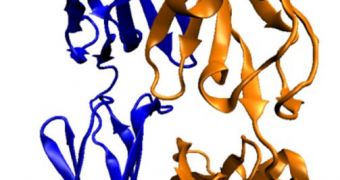In a paper published in last week's issue of the top scientific journal Nature Chemical Biology, a group of scientists from the University of Bristol, in the United Kingdom, announces the development of a new protein. The type of architecture this molecule contains does not exist in nature.
The artificial protein was designed by a group of biochemists, mathematicians and chemists from first principle. It represents an improvement brought to nature, since millions of years of evolution could not enable the emergence of such a complex molecule in lifeforms on Earth.
Proteins are widely-known to be the building blocks of life, alongside RNA, DNA and amino-acids. There are countless combinations of shapes and sizes for proteins, and many such molecules differ in function, but not shape or basic architecture.
Researchers included 6 polypeptide chains in the protein, which they called CC-Hex. The chains are not based on any existing, naturally-occurring analogs, and each of them folds in on itself to create a helix-like structure. The six helices lead to the creation of a bundle-like formation.
Interestingly, when viewed from the exterior, the protein appears to feature a ring of polypeptide chains surrounding a central channel. Innovative designs, chemical synthesis and X-ray crystallography are all techniques that can be further used to improve the molecule's architecture.
“This is an exciting time for our labs,” says professor Dek Woolfson, one of the leaders of the new work. He coordinated the UB research group with professor Leo Brady, the other co-leader of the investigation.
“Not only have we found a part of protein space that nature seems to have neglected, but we believe that the new structure will allow us to engineer protein functions much more rationally and confidently than has been possible before,” Woolfson explains.
The team hopes to use this protein as a starting point for the creation of new enzymes, ion channels and even additional proteins. The thing that could enable these types of study is the protein's ability to remain stable when its internal chemistry is altered with external modifications.
Naturally-occurring proteins have exactly the same capability, and one of the UB team's main goals was replicating this as well. Within a few years, researchers expect to have access to a wide array of new proteins to work with.

 14 DAY TRIAL //
14 DAY TRIAL //